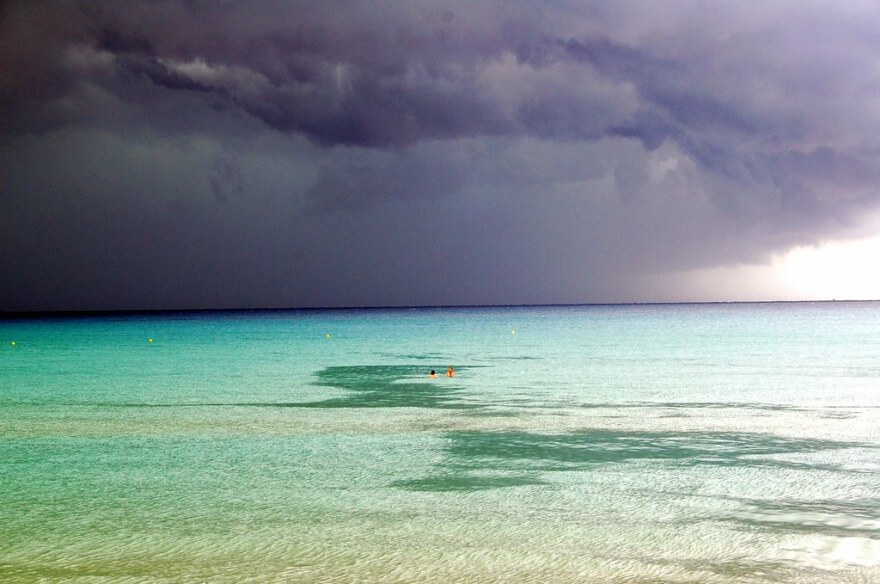The Great Lakes region is seeing more intense rainstorms.
Storms that were once considered 100-year events or even 500-year events are happening every few years now. Climate change models project it’s getting worse.
That will mean even more flooding for some towns.
Some people say there’s a way to reduce that flooding: more wetland areas.
We’re trudging through more than a foot of snow to look at a project at the Shiawassee National Wildlife Refuge.
“What we're seeing right now is almost all fully restored now. Back in 2013, this was all corn and soybeans and agricultural land.”Kali Rush
That’s Eric Dunton, a biologist with the U.S. Fish and Wildlife Service. That agricultural land is now restored wetland that’s managed by flood gates and levees. The Shiawassee refuge sits right where the Tittabawasee, Shiawassee, Cass, and Saginaw all come together on their way to Lake Huron’s Saginaw Bay.
Last year when the Wixom Lake dam gave way and the Sanford Lake dam was breached, more than 21 billion gallons of water rushed into the Tittabawassee River. Towns downstream were facing major flooding.
“So we opened up all the water control structures and within about 30 hours of opening those structures, we had 10 feet of water across the entire thousand acre marsh.”
That means a substantial portion of the flood waters were diverted away from towns along the rivers. More than three and a quarter billion gallons. That’s something close to five thousand Olympic size swimming pools.
Not only did it prevent worse flooding downstream, but it acted as a pressure relief valve for the waters upstream, reducing the amount of flooding in Midland.
“I think that every day society and people are realizing the benefits of wetlands more and more”
This is Chris Sebastian with the conservation group Ducks Unlimited.
“And I think that we are now realizing that draining these 100, 150 years ago to make way for progress back then really is hurting us now.”
Ducks Unlimited helped the U.S. Fish and Wildlife Service design the new 1000 acre managed wetlands – which is more complicated than it sounds.
“It turns out that putting nature back on the ground is pretty expensive and, you know, trying to make things natural that were here before us, it's really hard to do.”
Here at Shiawasee, failing to get it right would mean flooding neighboring farms.
It involves engineers and and other experts. One of those experts involved in this project is Kali Rush, a regional biologist for Ducks Unlimited. She says Michigan has lost a lot of its wetlands due to first timber harvesting and then farming.
“There was wetlands around Saginaw Bay where we are here, you know, it stretched maybe over 10 counties.”
Now there’s only a fraction of those wetlands remaining. So, water has no place to go when there’s a big rain. And we’re seeing more big rains.
“We need to mimic the natural fluctuations of the wetlands, which allows us to raise or lower water levels and promote that native vegetation response, which then, you know, does all the things that we've been talking about, provides the wildlife habitat, provides for flood storage and cleans the water and cleans the air.”
And those things help in a lot more ways than the obvious. Wetlands filter pollutants, farm chemicals and other bad stuff. The wildlife habitat serves more than just ducks, but also egrets, great blue herons, otters, eagles, and is a place for some kinds of fish to reproduce.
But if you never hunt ducks, or take hikes to see birds, or fish, Rush says you still can benefit. Wetlands can mean the difference in whether sewer systems back up into your basement, or that nearby creek rises to your doorstep.
“The goal in the future would be to better prepare for these larger storms and to have more of these, you know, wildlife refuge areas, more these wetlands on the landscape, to be able to uptake more of those floods and really lessen the impact on people.”
Because so many wetlands have been drained, filled in, built over or destroyed some other way, we’ve taken away one of nature’s ways of handling too much water along rivers or along Great Lakes coasts. Instead, we’ve been trying to build bigger networks of bigger pipes to rush water back to the rivers and lakes. That’s really expensive and increasingly we’re finding not all that effective with the way the climate is changing in the Great Lakes region.

